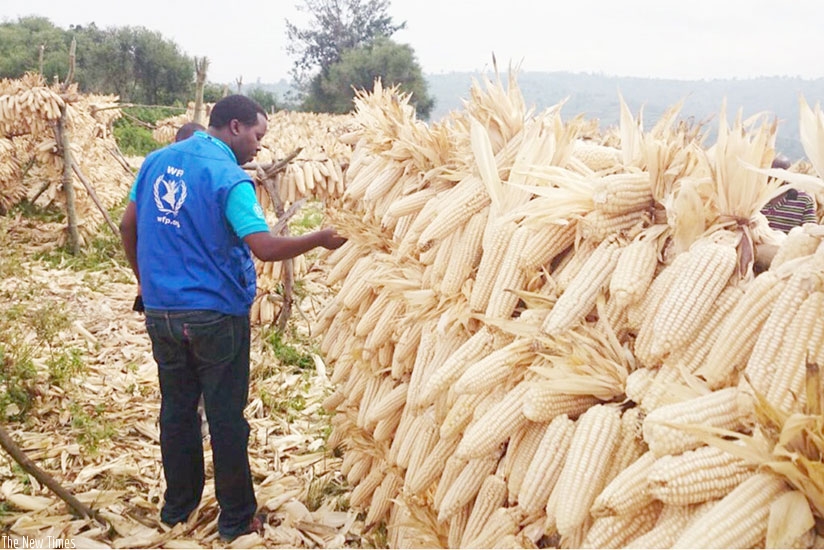WFP is one of the largest humanitarian organizations addressing the challenges of global hunger and malnutrition. It is this context that, every day, WFP and its partners work to achieve the vision of a zero hunger world.


WFP has helps farmers to find good markets and get better prices. (Courtesy)
WFP is one of the largest humanitarian organizations addressing the challenges of global hunger and malnutrition. It is this context that, every day, WFP and its partners work to achieve the vision of a zero hunger world. To achieve this goal, the world needs to make nutritious food accessible and available all year round, to eliminate stunting, to increase rural economic opportunity, to prevent food waste and to promote sustainable agricultural development. WFP’s strategy in Rwanda is to contribute to national approaches towards making the country food secure, where people are well nourished, able to develop to their full potential and living in resilient communities. WFP believes that achieving zero hunger requires moving beyond saving lives to changing lives, by focusing first on the people in greatest needs.
WFP’s innovation
WFP’s innovation allows members of farmer organisations to form solidarity groups of at least 10 members each, with each member saving ten percent of the amount of money needed to reach the minimum threshold at which the micro-financial institution can allocate financial credit ten folds of the individual savings. Calixte Ufitamahoro is the president of Abiyunze-Kinazi farmers’ organisation based in Ruhango district, south of Rwanda. He is happy, as his cooperative managed to acquire 5.9 million RWfrancs from CLECAM-Ejoheza to enable members to purchase farm inputs.
Through the solidarity group innovation, Claudine Uwimana, a 42 year mother of 4, received a loan of 100,000 Rwandan francs from CLECAM to pay for farm inputs including maize seeds and fertilizers. "I’m happy and confident that I will be able to pay my loan back, and on time” said Claudine.
Members of Abiyunze-Kinazi farmers’ organisation have been keen to state that this initiative has helped them to adopt good savings habits and to use these savings as collateral to access loans from microfinance institutions.
"Since farmers are very interested in the new scheme, we have already opened a mobile branch in Ruhango, Southern Rwanda, to better serve members of farmers’ organisations accessing loans without difficulties” said Ignace Havugiyaremye, Manager of CLECAM-Ejoheza micro-finance. "As a result of easy access to input loans, members of Abiyunze farmers’ organisation have been able to buy farm inputs on time and claim they may expect a high output at the end of the season because of it, with at least over 210 metric tons of maize, worth USD 60,000” said Calixte, the president of Abiyunze. "We will be able to repay the loan without any issues after that harvest” Calixte added.
Investment in Food Security and Rural Development
WFP is investing in the improvement of food security and living standards and the reduction of poverty in vulnerable communities by combining WFP’s Food for Assets model with Korea’s experience with the Saemaul Undong (New Village Movement) approach to rural development. Over 100,000 people have been mobilised for cash-for-work, creating over USD 3 million worth of assets in Nyamagabe, Karongi and Rutsiro districts. WFP builds community assets through road rehabilitation, land terracing, marshland reclamation, construction of houses and water supplies to the most vulnerable members of the community, and builds the small-holder farmers’ post-harvest management skills. Such an integrated approach helps reduce food security and encouragessustainability.
WFP provides storage facilities to reduce post-harvest losses
With smallholder farmers losing up to 30 per cent of their harvest to pests and mould due to poor storage, WFP has provided storage facilities including warehouses, plastic bags and silos to small-holder farmers to prevent food loss. The programme also helps farmers to find good markets and get better prices.
Ruth Mukamana, a 33 year-old mother from North eastern Rwanda, is among hundreds of smallholder farmers who have received storage facilities from WFP to boost food storage capacity at the household level for sustainable food security. Ruth and her husband Dionese Riberakurora, had previously lost big portions of their harvest due to poor storage, which meant they did not have enough to feed their family. Thanks to the grain silo her family received from WFP that has all changed.
"I stored 750kgs of maize in the silo after the harvest in June last year” Ruth explained. "I was able to keep the maize in good condition for us to eat right up to the next harvest season and lost nothing.”
The storage units are all water resistant, rodent and pest proof, air tight and highly durable. This guarantees long term preservation of food without need to add any chemicals. As a result, farmers have been able to save money which would have been spent on fumigation. The facilities enable farmers to retain over 98 percent of their harvest in good condition and contribute to an improved household income.


